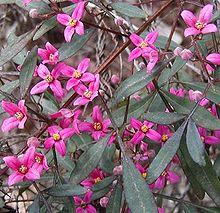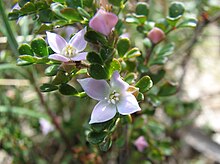
Correa is a genus of eleven species of flowering plants in the family Rutaceae that are endemic to Australia. Plants in the genus Correa are shrubs to small trees with simple leaves arranged in opposite pairs, bisexual flowers with four sepals, four petals usually fused for most of their length and eight stamens.

Eriostemon is a genus of flowering plants of the family Rutaceae. It is native to eastern Australia and includes just two species, E. australasius and E. banksii. Eriostemon australasius, commonly known as pink wax flower, occurs between Fraser Island and Nowra and is a shrub of heathlands and low open woodlands. Eriostemon banksii is endemic to Cape York Peninsula and is a shrub or small tree occurring in heathland and rainforest margins.
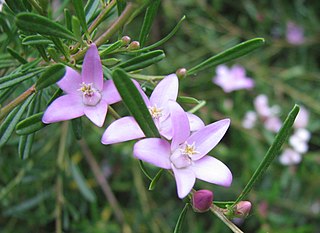
Crowea is a genus of small evergreen shrubs in the family Rutaceae, sometimes known as waxflowers. There are three species and many subspecies and cultivars, all of which are popular as ornamentals because of their abundant, attractive flowers which often occur during autumn and winter. Crowea species are all endemic to Australia, where they occur in Victoria, New South Wales and Western Australia.

Zieria is a genus of plants in the family, Rutaceae. About sixty species have been formally described, all of which are endemic to Australia except for one species which is found in New Caledonia. They occur in all Australian states except Western Australia but the genus is under review and a number of species are yet to be described or the description published. Zierias are similar to the better known genus Boronia but can be distinguished by the number of stamens in the flowers. The name Zieria honours the Polish botanist John Zier.

Boronia pinnata is a plant in the citrus family, Rutaceae, and is endemic to New South Wales. It is an erect, woody shrub with pinnate leaves and groups of between three and forty pink flowers arranged in leaf axils. It flowers in spring and early summer and is found in coastal areas between Ballina and Jervis Bay.
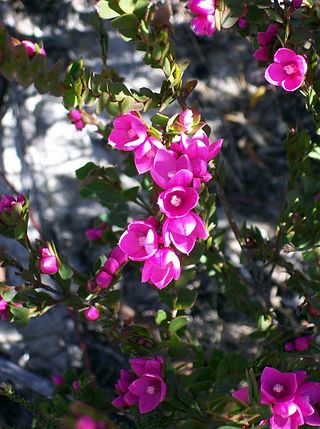
Boronia serrulata, commonly known as native rose or rose boronia, is a species of plant in the citrus family, Rutaceae, and is endemic to New South Wales, mainly in the Sydney basin. It is an erect, woody shrub with glabrous branchlets, simple, egg-shaped leaves with fine teeth on the edges, and bright pink, four-petalled flowers on the ends of the branchlets.

Zieria smithii, commonly known as sandfly zieria, lanoline bush or Smithian zieria, is a plant in the citrus family Rutaceae and is endemic to eastern and south-eastern Australia. It is a robust shrub with its leaves composed of three leaflets, and groups of flowers with four white petals, the groups usually shorter than the leaves. It is common and widespread along the coast and adjacent ranges.

Zieria aspalathoides, commonly known as the whorled zieria, heath zieria, hairy zieria or heathy zieria, is a plant in the citrus family Rutaceae and is endemic to eastern Australia. It is a heath-like shrub with leaves that appear to be whorled and with pink flowers in groups of three, each with four petals and four stamens.

Zieria prostrata commonly known as headland zieria, is a plant in the citrus family Rutaceae and is endemic to the Coffs Harbour district in New South Wales. It is a prostrate shrub with leaves composed of three leaflets, and flowers with four pink to white petals. It is only known from four headlands and is classified as an endangered species.
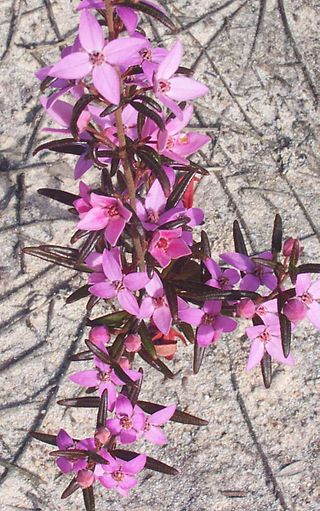
Boronia ledifolia, commonly known as the Sydney boronia, showy boronia or ledum boronia, is a plant in the citrus family Rutaceae and is endemic to south-eastern Australia. It is a shrub with simple or pinnate leaves which have a strong odour when crushed, and pale to bright pink flowers. Although difficult to propagate, this boronia is a popular garden plant.

Boronia crenulata, commonly known as aniseed boronia, is a plant in the citrus family Rutaceae and is endemic to the south-west of Western Australia. It is an open-branched shrub, often trailing between other plants, has strap-like leaves and pink to purple-red, four-petalled flowers in winter and autumn.
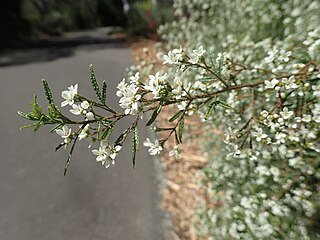
Zieria adenodonta, commonly known as the Wollumbin zieria, is a plant in the citrus family Rutaceae and is endemic to eastern Australia. It is a dense, bushy shrub with leaves composed of three leaflets which are warty on the upper surface. In winter and early spring it has groups of five to eight flowers, each with four white petals, the groups usually shorter than the leaves.
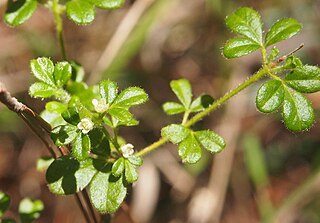
Zieria minutiflora, commonly known as twiggy zieria, is a plant in the citrus family Rutaceae and is endemic to eastern Australia. It is a small, erect, twiggy shrub with leaves composed of three leaflets, and clusters of small white flowers with four petals and four stamens. It usually grows as an understorey shrub in eucalypt woodland.
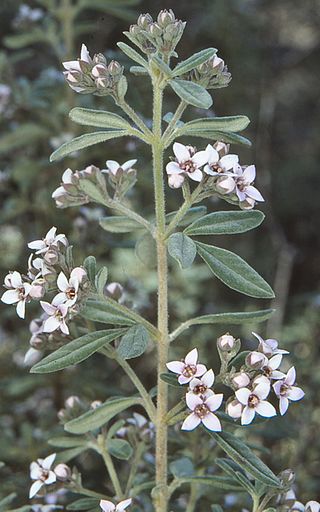
Zieria cytisoides, commonly known as the downy zieria, is a plant in the citrus family Rutaceae and is endemic to eastern Australia. It is a bushy shrub with three-part, clover-like leaves and small clusters of pale to deep pink flowers with four petals and four stamens.
Zieria inexpectata is a plant in the citrus family Rutaceae and endemic to south-eastern Queensland. It is a small, compact shrub with erect, wiry branches, three-part leaves and groups of up to twelve white flowers, the groups longer than the leaves and the flowers with four petals and four stamens. It was unexpectedly discovered by the authors during a field trip and its discovery led to a paper describing the zierias of Queensland, including sixteen new species.
Zieria laxiflora, commonly known as wallum zieria, is a plant in the citrus family Rutaceae and is endemic to eastern Australia. It is an erect shrub with leaves composed of three leaflets, and clusters of about nine white or pale pink flowers with four petals and four stamens. It usually grows is coastal heathland.

Zieria southwellii is a plant in the citrus family Rutaceae and is endemic to eastern Australia. It is a large shrub or small tree with its leaves composed of three leaflets, and has groups of large numbers of flowers with four white petals, the groups shorter than the leaves. It grows near rainforest in northern New South Wales and far south-eastern Queensland.
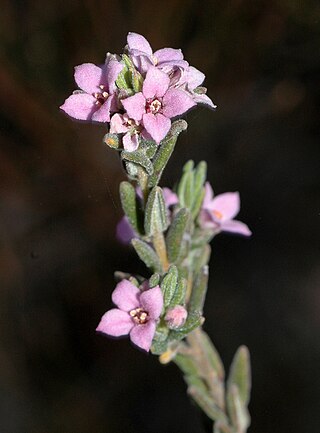
Zieria veronicea, commonly known as the pink zieria, is a plant in the citrus family Rutaceae and is endemic to south-eastern Australia. It is a small, lemon-scented shrub densely covered with velvety hairs. Up to three flowers with four pink petals appear in leaf axils in late spring.

Boronia parviflora, commonly known as the swamp boronia, small boronia, tiny boronia, or small-flowered boronia, is a plant in the citrus family Rutaceae and is endemic south-eastern Australia. It is a weak, low shrub with elliptic to egg-shaped leaves with finely toothed edges and up to three pink, white or green four-petalled flowers arranged at or near the ends of the stems.

Cyanothamnus polygalifolius, commonly known as dwarf boronia, milkwort-leaved boronia or milkwort boronia, is a plant in the citrus family Rutaceae and is endemic to eastern Australia. It is a low-lying shrub with simple leaves and white or pink flowers arranged singly or in groups of up to three in leaf axils.
